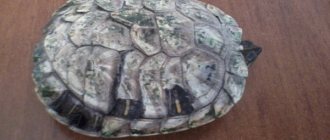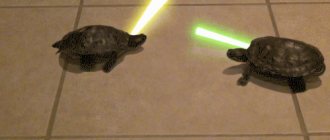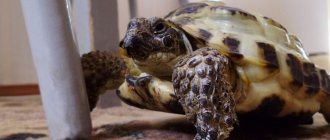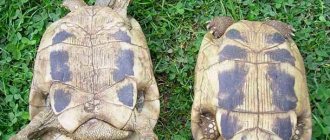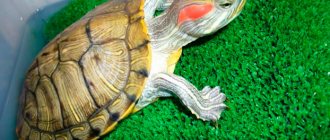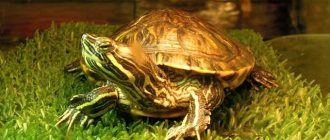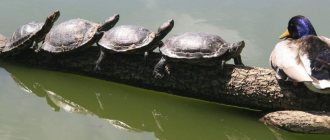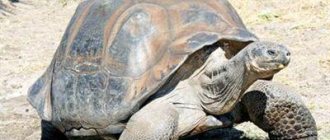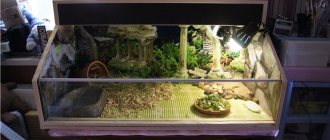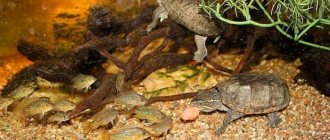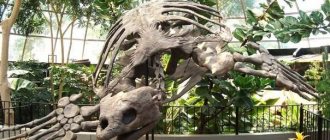The structure of the turtle penis
The male reproductive system consists of appendages, vas deferens and testes.
Puberty in reptiles lasts up to several decades. The testes are cylindrical or oval in shape. These organs are located along the midline of the body, connected to the vas deferens, which are the Wolffian canals (renal ducts). The vas deferens open into the ureters located near the cloaca.
The structure of the turtle's reproductive system
Spermatogenesis (sperm development) occurs under the influence of pituitary hormones and occurs in 4 phases:
- Regenerative.
- Progressive.
- Accumulation phase.
- Regression.
During this period, sperm is transported through the vas deferens to the copulatory organ, the penis. It enters the unpaired copulatory organ of the reptile; during the breeding season, the penis increases in size so much that it protrudes beyond the cloaca.
General characteristics of the class reptiles
Origin
Reptiles evolved from primitive Devonian amphibians (stegocephalians) during the Carboniferous period of the Paleozoic era (the most primitive ancient reptile is Seymouria). Ancient reptiles (ichthyosaurs, brontosaurs, tyrannosaurs, diplodocus) inhabited water and land, pterosaurs were flying dinosaurs.
Read: Class amphibians or as they are also called amphibians #28
Main features of reptiles
Features of reptiles as true land animals: thick dry skin with horny scales, a strong ossified skeleton, a rib cage, differentiated respiratory tract and cellular lungs, an incomplete septum in the ventricle of the heart, the rudiments of the forebrain cortex, secondary (pelvic) kidneys, internal insemination and telolecithal eggs , shell membrane of the egg and germinal membranes - serosa and amnion.
Read: Superclass fish as a group of chordates #27
External structure
Diagram of the structure of the reptile: A - dissected crocodile;
B - brain; In heart; 1 - olfactory lobes; 2 - forebrain hemispheres; 3 - midbrain; 4 - cerebellum; 5 - medulla oblongata; 6 - lungs; 7 - stomach; 8 - dorsal aorta; 9 - small intestine; 10 - testis; 11 - kidney; 12 - tail; 13 - cloaca; 14 — hind limbs; 15 - large intestine; 16 - liver; 17 - left ventricle; 18 - right ventricle; 19 - pulmonary arteries; 20 - pulmonary vein; 21 — right aortic arch; 22 - forelimb; 23 - trachea; 24 - esophagus; 25 — left aortic arch; 26 - right atrium; 27 - left atrium; 28 — intrapancreatic septum; 29 - ventricle of the heart. The external structure of reptiles is varied and is associated with adaptation to the method of movement. In lizards, crocodiles and chameleons, all parts of the body are expressed: head, torso, tail, front and rear five-fingered limbs. The humerus and femur are parallel to the surface of the earth, so the body of these reptiles sags and touches the ground - reptiles. Snakes have a cylindrical body, devoid of limbs; the trunk and caudal sections merge into each other without a sharp boundary. In turtles, the body is flattened in the dorso-ventral direction and is enclosed in a shell consisting of dorsal and abdominal shields. The limbs are short, the neck is long and mobile.
Read: Chordates as one of the types of animals #26
Coverings of the body
The skin consists of epidermis and dermis, it is dry and practically devoid of glands, covered with horny scales and scutes - derivatives of the epidermis. Body coverings protect reptiles from mechanical damage and water loss. Scales inhibit growth; keratinized skin, which interferes with the growth of reptiles, is shed during molting. In some species, under the horny scales there are bone plates that form the shell (turtles).
Read: Arthropods as one of the types of animals #25
Musculoskeletal system
The skeleton of reptiles mainly consists of bone tissue. Ossification of the skeleton has significantly increased its strength, so the body size of reptiles is larger than that of amphibians, reaching 7-10 m (crocodiles and pythons). The skeleton consists of three sections: the skeleton of the head (skull), the skeleton of the torso, the skeleton of the limbs and their girdles.
Read: Mollusks as a type of invertebrate animals #24
Scull
The skull has an elongated shape due to lengthening of the bones, and the volume of its brain section increases. A hard palate appears, separating the nasal cavity from the oral cavity. The skull is connected to the spine by one condyle of the occipital bone. The first two cervical vertebrae (atlas and epistropheus) form a movable connection with the skull. Mobility of the head is also ensured by a flexible neck.
Read: Annelids as a type of animal #23
Spine
The spine consists of 5 sections: cervical (8-10 vertebrae), thoracic (5), lumbar (17), sacral (2), caudal (several dozen vertebrae). The anterior ends of the long ribs of the thoracic spine connect to the sternum to form the rib cage.
Read: Roundworms as one of the types of animals #22
Limbs
The limbs and their girdles are firmly strengthened, the skeleton of the girdle of the forelimbs contains paired shoulder blades, collarbones and crow bones connected to the sternum - the shoulder girdle through the sternum and ribs, unlike amphibians, received support from the spine. The skeleton of the hind limb girdle is formed by three pairs of bones (iliac, ischial and pubic), fused with each other and with the sacral vertebrae, forming the pelvis, which is a strong support for the hind limbs. The skeleton of the free fore and hind limbs contains the same bones as those of amphibians; the fingers have claws. In snakes, the spine is formed by only two sections (trunk and caudal), the sternum, the skeleton of the limbs and their girdles are reduced.
Read: Flatworms as a type of animal #21
Musculature
The muscles are more differentiated than in amphibians - neck muscles, intercostal muscles, flexors and extensors of the fingers, subcutaneous muscles, and abdominal muscles appear.
Read: Coelenterates as one of the types of animals #20
Digestive system
The digestive system has a greater length and degree of differentiation into sections than in amphibians. Reptiles are predominantly predators (they feed on animal food: small terrestrial and aquatic invertebrates, sometimes fish, amphibians, birds, rodents), but there are herbivores (iguanas and turtles).
The oral cavity is separated from the pharynx, there is a tongue and jaws with uniform conical teeth. The teeth of reptiles capture, hold, tear and kill prey, but do not chew it. Therefore, most species swallow food whole. The teeth of most reptiles are fused, but in crocodiles they are immersed in special cells (alveoli). The muscular tongue can extend far from the mouth - in lizards and snakes it is forked, serves as an organ of touch and taste, and in chameleons it is a device for capturing prey.
The secretion of the salivary glands facilitates the swallowing of food, contains enzymes, and in some snakes and lizards this secretion is poisonous. This is followed by the pharynx, esophagus and stomach with thick muscular walls, small and large intestines, the rudiment of the cecum, and the cloaca.
There is a liver with a gallbladder and a pancreas. Food in reptiles is quickly digested only at high temperatures. At low temperatures, some species, especially turtles and snakes, sharply reduce the intensity of their vital activity and are able to starve for a long time.
Read: Animals as one of the kingdoms of living nature #19
Excretory system
Excretory system - secondary (pelvic) kidneys, which provide active reabsorption of water from primary urine and produce concentrated urine. Urine passes through the ureters into the cloaca and accumulates in the bladder. The main metabolic product is uric acid.
Read: Classification of flowering plants #18
Respiratory system
Due to the thickening and roughening of the skin, the only respiratory organs of reptiles are the lungs. The respiratory tract begins with the nasal cavity, which has external respiratory openings (nostrils) and internal respiratory openings (choanae), which open into the oral cavity. This is followed by the larynx and trachea, the posterior end of which branches into 2 bronchi entering the lungs. The walls of the trachea and bronchi do not collapse due to the development of cartilaginous rings in them. The lungs of lizards and snakes have a fine-mesh structure, and turtles and crocodiles also have internal partitions that make the lungs spongy and increase the area for gas exchange. Respiratory movements are ensured by contraction of the intercostal muscles, which increase the volume of the chest.
Read: Seed as one of the plant organs #17
Circulatory system
The heart of reptiles is three-chambered, consisting of two atria and one ventricle, which has an incomplete septum. Crocodiles have a four-chambered heart. Blood vessels are combined into two circulation circles. Three vessels depart from different parts of the ventricle independently of each other (the arterial cone is reduced). The pulmonary artery departs from the right side of the ventricle, carrying venous blood to the respiratory organs (pulmonary circulation). Oxidized blood returns through the pulmonary veins to the left atrium. The right aortic arch departs from the left part of the ventricle, which carries arterial blood to the head and forelimbs (large circle), from the middle of the ventricle - the left aortic arch, which receives mixed blood (large circle). After going around the heart, the two aortic arches merge into the dorsal aorta, through which mixed blood with a higher oxygen content flows to all internal organs, the muscles of the trunk and the hind limbs. Through the vena cava system, venous blood is collected in the right atrium. Reptiles are cold-blooded (poikilothermic) animals that do not have a constant body temperature and use external heat for heating; when the temperature drops greatly, they fall into stupor.
Read: Flower as a generative organ of plants #16
Brain
The brain has 5 sections: medulla oblongata, posterior, middle, intermediate, anterior. The volume of the forebrain is much larger than that of amphibians; a cortex appears on its surface in the form of three islands (in reptiles, conditioned reflexes are more easily developed, their reflex activity and behavior are more complex). The cerebellum is better developed, it is larger and more complex, so reptiles have greater mobility and variety of movements. There are 12 pairs of cranial nerves originating from the brain. The nerve plexuses innervating the limbs are better developed than in amphibians.
Read: Leaf as a vegetative organ of a plant #15
Sense organs
The visual organs are well developed. The eyes are protected by two movable eyelids (upper and lower) and a nictitating membrane, and in some species (snakes, lizards) by fused eyelids. The eyes cannot retract into the oral cavity, like those of a frog (hard palate), and only perform rotational movements. The lens is capable of changing curvature. Most diurnal species have color vision. Some reptiles that hunt at night have a parietal eye that senses infrared radiation. The organ of hearing is the inner and middle ear with one auditory ossicle (stapes) and the eardrum. The organs of smell are the receptors of the nasal cavity, touch and taste are the forked tongue.
Read: Plant shoots and stems and everything about them #14
Reproductive system
Reptiles are dioecious animals. Testes and ovaries are paired. The vas deferens and oviducts carry reproductive products into the cloaca. Males have a copulatory organ. Insemination is internal, fertilization occurs in the upper part of the oviduct. Most species lay eggs, and some snakes are ovoviviparous (embryos develop in the eggs, which are retained in the oviducts so that the young hatch immediately after they are laid). Eggs contain a large supply of nutrients (yolk), have a shell (in turtles and crocodiles) or leathery (in snakes and lizards), which protect them from mechanical damage. The number of eggs in a clutch is from 1 - 2 to several dozen (for a lizard - 5 - 15); they are buried in the ground in well-heated places or in rotting garbage. Females of some species (pythons, crocodiles) guard the clutch of eggs.
Unlike fish and amphibians, development in reptiles is direct. The embryo develops inside the egg in an aqueous environment formed by the amnion embryonic membrane. The nutrients necessary for the growth and development of the embryo are contained in the yolk, and water is contained in the liquid protein layer of the egg. Gas exchange between the embryo and the external environment occurs through the serous germinal membrane.
Read: Root as a vegetative organ of plants #13
Meaning
Meaning of reptiles:
- components of biogeocenoses, links in food chains;
- source of human food (turtle meat and eggs, snake meat);
- source of raw materials for industry (snake and crocodiles skin);
- source of medicinal substances (snake venom);
- lizards and snakes destroy insects, mollusks and rodents - pests of agricultural crops;
- poisonous animals (viper, viper, cobra, rattlesnake).
Read: Flowering or angiosperms as highly organized representatives of the plant kingdom #12
Sexual and reproductive system of the female
In females, the reproductive system includes a pair of ovaries, resembling grape bunches in appearance, shell glands and oviducts. The ovaries, like the testes of males, do not perform any functions until the female reaches sexual maturity, but they grow and develop at the same time as the reptile.
The turtle has no uterus. During the breeding season, the oviducts increase significantly in size. They consist of the infundibulum, fallopian tube, isthmus, uterus and vagina. The ends of the oviducts emerge and open into the cloaca.
These bodies perform the following functions:
- preservation of seminal fluid;
- participation in fertilization;
- formation of membranes and shells of embryos;
- promotion of formed eggs.
The ovarian cycle in females occurs in 4 stages. In the first stage, the follicles enlarge. On the second, ovulation occurs. In the third stage, fertilization occurs. The fourth stage is regression, during which the genitals return to their normal state.
Sperm can be stored in the female's oviducts for a long time. After mating, the eggs can be fertilized not by fresh, but by old seminal fluid. After successful fertilization, the egg begins to descend through the oviduct. In its upper part, protein for eggs is produced, and in the lower part the shell is formed.
Animals with the biggest penises
Today we will talk about a topic that causes embarrassment and color on the face, but everything that is natural is not prohibited.
And so – the largest penises in animals! Mega sexy, with the largest penis on Earth is the Blue Whale. The average size of his genital organ is from 2 to 3 m, and the girth is 450 mm. Moreover, each blue whale testicle weighs approximately 70 kg, and if we take these dimensions into account, we can calculate that the whale’s ejaculate contains 20 liters of seminal fluid, which is equal to 7 three-liter jars.
But, despite such shocking dimensions, in relation to the length of the body, the penis does not seem so big: only 1:12.
The African elephant, which can be proud of its dignity and can be up to 2 meters long, is not inferior in this regard. The ratio of the reproductive organ to the body weight of the animal is 1:4.
When aroused, a sea turtle's penis increases by 50% in length, 75% in girth and 10% in depth. In most turtles, the erect penis reaches half the length of their body. Thus, a two-meter turtle has a penis equal to one and a half meters. For turtles, such a great dignity has not only a sexual purpose, but also serves as protection and intimidation.
The deep-sea squid has an ideal ratio of body weight to penis size, 1:1. When erect, the length of the squid's 38 cm penis reached 67 cm. This is the only living creature on the planet whose penis size in its normal state is equal to the length of its body.
Here is a banana slug, which reaches a length of 25 cm. Its genital organ, located on the side of its head, is the same size. By nature, banana slugs are hermaphrodites, and therefore, thanks to their unique penis, they can impregnate each other and become pregnant.
The largest penis in the world relative to body size, with a ratio of 40:1, is possessed by immobile crustaceans that spend most of their time on the stone, warming and growing their genitals for successful fertilization.
The leadership among rodents belongs to field mice. With a body length of 12 cm, the size of their genital organ reaches 8 cm, which is more than half of the animal’s body. For such a modest mouse, the size is very impressive. And if they suddenly call you a mouse, hinting at your dignity, take it simply as a compliment.
An amazing discovery was a small ancient creature - an Ostracod, whose penis length to its body was 1:5. Such a ratio in terms of a person would mean the size of the penis, which would be about 40 cm. The length of the sperm is 1 cm, while the size of the creature itself does not exceed some 5 mm.
Related in this matter are fruit flies - Drosophila, which are capable of producing sperm 5 cm long, considering that the fly itself is only 0.25 cm long. It is not difficult to compare and understand that the sperm produced is 20! times the length of the body of a living creature.
We saved the Argentine duck for a snack. At first glance it looks like an ordinary duck, which will certainly be good when cooked. But this is not just any duck, but a giant duck: the size of its penis is twice the length of its body. And if the size of the bird is on average 20 cm, then the genital organ reaches 42 cm. It is quite easy for the animal to move with such dignity, and all thanks to the fact that the genital organ of the duck has a spiral shape. In addition, the vagina is of the same shape, which twists in the opposite direction, helping the duck to prevent fertilization.
But who is definitely not interested in sex and world records are polar bears, whose libido decreases under the influence of Arctic air pollution and their genitals become smaller, which becomes a real mystery for scientists.
In the table we have collected the best indicators of maleness among large animals.
And gorillas and orangutans have the smallest penises among animals in relation to their body weight. With a mass of 200 kg, the male gorilla's manhood is only 4 cm long.
Development of the embryo and offspring of the turtle
Turtle embryos develop in the amniotic way (direct development is called).
Embryogenesis (formation of embryos) in these reptiles occurs in 4 stages and lasts about 30 days:
- Splitting up. At this stage, a blastula is formed. The zygote begins to divide into small cells.
- Gastrulation. At this stage, a two-layer embryo is formed, but it does not yet increase in size.
- Primary organogenesis. At this stage, the embryo develops a primary gut, notochord, and neural tube. The formation of axial organs also occurs.
- Secondary organogenesis. At this stage, the formation of all other organs of the embryo occurs: kidneys, lungs, heart, etc.
The shell of embryos begins to form on the 10th day. The ribs turn, grow upward, and eventually fuse together to form a shell.
Females are able to store sperm for a long time
Turtles are able to freeze the development of embryos inside the egg. Why do they block the access of oxygen?
At home, eggs are incubated in the same way as bird eggs - in an incubator. When moving the clutch, remember that turtle eggs should never be turned over.
Characteristics and ecology of the marsh turtle
The best known is the marsh turtle (Emys orbicularis), characterized by a black shell with a fine pattern of yellowish speckles; the length of the dorsal shield is up to 32 cm. Widely distributed in the Crimea, the Caucasus and the south, reaching the Central Black Earth Region.
The turtle prefers standing or slowly flowing shallow waters; The animal positively avoids fast, clean rivers: it is difficult for a clumsy and heavy turtle to fight the current. During the day, turtles sit for a long time on the coast and hummocks, basking in the sun for hours. When a person approaches, they fall into the water with a loud splash and usually swim to the bottom of the reservoir. The turtle's food consists of small aquatic animals: worms, water insects, frogs, newts, larvae of these amphibians, as well as small fish. If torn fish bladders float on the surface of the water of a pond, we can say with a high degree of certainty that these are the remains of a turtle’s feeding, indicating the presence of a clumsy aquatic predator there. To lay eggs, turtles choose relatively dry places near their native pond. In Khrenovsky pine forest in the river valley. In Bityug (Central Chernozem Region), turtles choose to lay on the tops of dry sand or turf dunes adjacent to reservoirs.
The turtle moistens a convenient place on the sandy soil, releasing the aqueous contents of its anal sacs, which are two large thin-walled bladders, richly supplied with blood vessels. Each sac opens between the hindgut and the cloaca. When a captured turtle is removed from the water, the animal often sprays a stream of water—the contents of its anal sacs—from its anus. Before laying eggs, the turtle digs a special hole in moist soil. In this case, the animal drills a cone-shaped hole with its tail, strongly straining its muscles, pressing the end of the tail to the ground and making rotational movements with its body. Having broken through a similar hole in the earthen soil, the turtle continues to dig a hole with the help of its hind limbs, scooping out sand or earth alternately with its right and then left paw. As a result of the work, which sometimes lasts several hours, a deep ovoid hole about 12 cm in diameter is obtained. After lying for some time on the edge of the hole, the turtle begins laying eggs. The emerging egg is accepted by the animal on the flat foot of its hind paw and carefully lowered to the ground. The clutch contains from 8 to 12 eggs. No earlier than half an hour after laying, the animal begins to dig a hole, working alternately with its hind legs. The final stage is to level the soil by trampling with the back of the abdominal shell a small mound formed above the hole at the bottom of which the eggs are laid. In our south, turtles lay eggs during June. The cubs, reaching a length of 15-20 mm, hatch from eggs in the fall of the same year.
Clutches of turtle eggs often suffer from predators. So, in the Khrenovsky forest, where there are many foxes, you can often see fox tracks on the sand dunes, especially after an overnight rain. Predators wander in search of underground egg clutches, easily tear them apart and eat them. Usually, the fox, without breaking the shell, makes a side hole in the wall of the egg with its incisors and drinks the contents. The fox, in his search for turtle eggs, is probably guided by instinct; she digs in the sand and sniffs out the places where turtle eggs lie.
In Transcaucasia and Iran, the Caspian water turtle (Glemmys caspica; Fig. 3) is common, differing from our marsh turtle in the dense and motionless connection (along the seam) of the dorsal and ventral shields. In the genus Emys these shields are connected by a more or less movable ligament.
Rice. 3. Caspian turtle (Clemmys caspica).
Real land turtles and their characteristics. To the second subfamily of true land turtles (Testudininae) we include sedentary animals characterized by a relative convexity of the dorsal shield, which is tightly and widely connected to the abdominal shield. The limbs are columnar, with the fingers fused together; the claws are large, massive and somewhat blunt at the ends. In contrast to the sharp small claws of aquatic turtles, which lead a predatory life, the claws of land herbivorous forms are used for digging and are perfectly adapted for this. Among the representatives of our fauna, the Transcaucasian tortoise (Testudo ibera), also common in Africa, Syria, Iran and Asia Minor, and the Turkestan tortoise (T. horsfieldi), found in Central Asia from the Caspian Sea east to the Altai Mountains and south to Afghanistan, are well known . Turtles spend a relatively short, often snowless winter, for example, in the Kara-Kum desert, in a daze, burrowing into their sandy burrows since the fall. With the onset of spring, the desert quickly comes to life with 25 species belonging to 7 genera, distributed in Asia, North America and Africa.
Rice. 4 . Skull of Trionyx gangeticus from above and below.
1—nasal bones; 2—socket; 3—basal occipital bone; 4—lateral occipital bone; 5—superior occipital bone; 6—postorbital bone; 7—antorbital bone; 8—squamosal bone; 9—parietal bone; 10—frontal bone; 11—postfrontal bone; 12—anterofrontal bone; 13—square bone; 14—quadrate-zygomatic bone; 15—zygomatic bone; 16—jawbone; 17—premaxillary bone;. 18—choana; 19—“opener; 20—palatine bone; 21—pterygoid bone; 22—main sphenoid bone.
In our fauna there is only one representative, Trionyx maacki, whose dorsal armor reaches a length of 220 mm. Distributed on the Ussuri, Sungari rivers and Lake Khanka.
Diseases of the reproductive system
Males are susceptible to diseases such as prolapse or loss of the penis.
This happens for the following reasons:
- Weakened muscles responsible for retracting the penis. This may occur due to a deficiency of calcium and other nutrients.
- Injuries.
- A congenital pathology due to which the penis is squeezed out.
- The presence of stones in the bladder, enlarged kidneys, etc.
In many turtles, prolapse occurs in a chronic form, with the penis falling out on its own, but after a while it retracts back.
It is also necessary to inspect the turtle's cloaca for the presence of foreign bodies.
There are many bacteria present in turtle urine and feces.
If it falls out, it is set back. Before the procedure, the area adjacent to it is lubricated with antibiotic ointments. After reduction, the hole is sealed for 2-3 days. If this method does not help, the turtle should be shown to a veterinarian. With constant relapses of the reptile, surgical removal of the penis is indicated.
Reptiles tolerate this operation well. Unlike other pets, these reptiles use their penis only for mating, so its absence does not affect their quality of life in any way.
Penile prolapse in male red-eared turtles
Penile prolapse.
Penile prolapse (prolapse) is a relatively uncommon, yet regularly occurring pathology in the practice of a veterinary herpetologist. In a healthy sexually mature male, the penis leaves the cloaca cavity only during sexual activity and is easily retracted on its own.
Possible causes of prolapse: - weakness of the muscles responsible for retracting the penis (retractor muscles) due to a lack of calcium, vitamins, etc. (vitaminosis, hypocalcemia, dehydration (dehydration), sepsis). - pathology leading to extrusion of the penis from the body cavity (tympany, foreign bodies, accumulation of urinary sediment and stones in the bladder, enlarged kidneys due to nephritis). - injury to the penis, preventing its retraction into the cloaca. Thus, in a healthy male, the penis may not be reduced only due to injury to the organ itself. More often, the penis falls out for the second time in the presence of another disease. This is a metabolic disorder (vitaminosis, lack of calcium), leading to muscle weakness, or a lack of volume (space) under the shell with the development of pathological processes (bloated intestines, full bladder, enlarged kidneys). Hair loss can go away on its own if its underlying cause disappears. In some cases, the loss is chronic, i.e. the penis retracts and falls out again. Most often, the penis constantly gapes from the lumen of the cloaca.
Externally, penile prolapse looks like a “heart” or “rose” shaped formation gaping from the cloaca opening, usually black or dark red in color. The organ does not have any visible openings.
Penile prolapse of a male red-eared turtle.
Therapy for this pathology consists of eliminating the root causes and using various methods of repositioning and securing the penis inside the cloaca. In cases where the penis is irreversibly damaged, amputation of the penis is performed.
Top 10: Strange genitalia of the animal world
People have made genitals such a taboo subject that even mentioning them would make someone blush. However, animals are friendly with their genitals - and develop them in different directions. Size is not very important for them, but explosions, spikes and hypodermic injections are the opposite.
10. Sea Slug Hypodermic Penis
The colorful sea slug Siphopteron quadrispinosum has a penis that works much like a hypodermic syringe. The appendage, equipped with several large hooks at the base and a pair of needles at the tip, allows it to firmly attach to a female (female is a big word - sea slugs are actually hermaphrodites) and pierce her, injecting prostate juice. Having such a horribly decorated penis is of course harmful to their mates, but researchers believe that aggressive mating actually increases the chance of reproduction and fertility. Photo by Ayami Sekizawa
9. Double shark penises
Apparently, one penis is not enough for sharks. They definitely need two penises at once. Each organ is actually coiled cartilage that tenses when excited. So it's a functional penis, but with a twist. Once the penis is inserted into the partner, it opens like an umbrella in order to tie the sharks together. Oh, did we mention that the penis also has spurs? Apparently sharks like it rough.
LiveInternetLiveInternet
—Tags
—Categories
- Broadcast cuts. For those who don’t watch (Dom2) (4)
- Administration (108)
- House-2 news, rumors (13114)
- House-2 photos, screenshots (9188)
- House-2 blogs (880)
- House-2 opinion (6040)
- Dom-2 video (3013)
- House-2 humor (558)
- Our little brothers (all about animals) (1450)
- Home, family, children (372)
- Health, sports, beauty, fashion (907)
- Real jam! (recipes and cooking tips) (958)
- New day, discussions (572)
- Politics, economics, society (2935)
- From the world on news (1502)
- Man and the law (including incidents, crime) (393)
- Science and Technology (113)
- Obvious-incredible (232)
- History (facts from the past, retro photos) (693)
- Watch out, stars! (all about famous personalities) (1831)
- Cinema (films, trailers) (425)
- TV (shows, programs) (357)
- Music box (songs, videos) (257)
- Gallery (art, creativity) (223)
- Prose, poetry, quotes, aphorisms, incidents from life (434)
- Psychology, tests (475)
- Travelers Club (311)
- Humor, demotivators, cartoons, jokes, anecdotes (1518)
- Strawberry (everything recommended for viewing 18+) (70)
- Photo, video, animation, gif (1647)
- Leader of the day, congratulations on your birthday (165)
How to determine the sex of red-eared turtles
This question worries many who have decided to have an animal at home, but simply answering it is not so easy. To determine the sex of a red-eared slider, you need to wait until it reaches a certain age, when a number of signs begin to indicate its gender.
Having reached the age of 6-8 years, the red-eared slider is ready to breed. It is during this period that it is easiest to determine their sex, but already at 1.5-2 years, after analyzing all the combined characteristics, you can try to determine the sex of the red-eared slider. In order to determine gender, you should pay attention to the following features that can distinguish a boy turtle from a girl turtle.
External signs of male and female turtles
To determine the sex of a turtle, the animal must be sexually mature. In nature, turtles reach sexual maturity at the age of 6-8 years, at home - at the age of 2-5 years. At the same time, it should be borne in mind that the larger the animal, the longer puberty occurs.
If the age of the animal corresponds to the declared one, then we have the opportunity to find out the gender based on the following anatomical characteristics:
Claws
As a rule, the front claws of males are stronger and longer than those of females. Visually, this is quite easy to determine, because the difference in the length of the claws of males and females is quite significant. Long claws help the male hold the female during mating.
Another option for determining the sex of a turtle. To do this, you need to carefully examine the inside of its paws. If you find small scales, then you have a boy. In addition, males have femoral spurs.
Claw length
Male red-eared sliders have longer claws on their front feet than females. The male needs this in order to hold onto the female’s shell more firmly at the time of fertilization. Females have slightly shorter claws, but they are more blunt.
This method is quite simple, but can be misleading in the process of keeping them in captivity. Spending a lot of time on the island, the turtle can wear its claws. Here everything will depend on what material the sushi element is made of.
Reproduction of turtles
Turtles do not reproduce well in captivity. To do this, they need to create conditions close to the natural environment. With proper nutrition, a good microclimate and sufficiently free movement, the process of mating of clumsy reptiles is possible. They are able to be sexually active throughout the year.
The aquatic red-eared turtle is often kept as a pet. Individuals of different sexes are placed in a common terrarium and monitored when a relationship begins between the pair. Usually several females are placed with the male for the mating period. The male, unlike the female, has a longer tail and a notch on the plastron.
Features of the shell
By carefully studying the structure of the shell of a red-eared turtle, you can just as easily determine the gender of your pet. In order to facilitate the mating process, males have a shell with a concave abdominal part. Females do not have this feature.
If you look closely at the shape of the shell, it is different: males have a more elongated and elongated shape. In the area of the tail, the shape of the shell of males is similar to the Latin letter V, while in females it is more rounded. In the tail area, the female has a large hole, which facilitates normal egg laying.
Reproduction
Now let's find out how turtles reproduce.
Turtles reproduce by mating different sexes and laying eggs, which hatch into offspring.
In what cases does mating occur?
Breeding turtles at home is quite difficult.
To do this, it is necessary to make certain efforts and provide the necessary conditions:
- proper nutrition. It is necessary to include foods rich in vitamin E (vegetable oil, herbs) or vitamin preparations in your diet. Vitamin E has a positive effect on the reproductive system;
- arrange a suitable place for their habitat;
- provide animals with the opportunity to move.
Turtles have sex at any time of the year, provided they are well fed and warm.
Preparation
In order for mating to occur, it is necessary to have several sexually mature individuals of different sexes of the same species, and in no case different ones - this is important. The ratio is two males to one female.
It should be borne in mind that puberty in turtles occurs quite late. Individuals that are too young will not be able to bear offspring. But they shouldn’t be old either. The optimal age is 5 years. It is advisable to have the animals checked by a veterinarian first. Turtles must be healthy and not weakened. Males choose larger females, this must be kept in mind when choosing suitable candidates.
All animals selected for mating should be placed in one terrarium and their behavior observed. When mating games begin and pairs form, the extra turtles need to be moved to another place.
Mating process
How do turtles mate?
The male begins to vigorously jerk his head up and down. Then he extends his limbs, retracts his head and begins to swing and hit the female in the shell. If the female tries to escape, he catches up with her, hits and bites her until she obeys.
If mating does not occur, then it is necessary to seat the turtles and try to bring them together again after a few days.
After pregnancy occurs, the turtle is moved to another terrarium separately from the males.
Other signs of red-eared turtles
If there are turtles of the same age, you can try to determine their sex by their overall dimensions. Females are slightly larger than males because they will have to carry and then lay eggs.
Some experts point out that the male's muzzle has a more elongated shape than the female's muzzle. The female's muzzle has a more round outline. The paws of males have more pronounced spurs, which indicates that they are stronger than the paws of females.
Features of behavior
It is especially possible to determine the sex of red-eared turtles during the mating season. Behavioral characteristics indicate that each pet belongs to one gender or the other. During the mating season, the activity of males increases sharply. They organize all sorts of demonstrations to demonstrate their capabilities. At the same time, they actively swing their front legs, with much larger claws than the females have. During this period, they constantly chase females and make attractive head movements.
If someone is seriously involved in breeding red-eared turtles, then this article will be very useful, since at an early stage, before they are ready to reproduce, turtle pairs can be formed. In addition, such knowledge will help to correctly and accurately name pets, which is very important for many owners.
In pursuit of something unusual, it has recently become fashionable to keep exotic animals such as snakes, boa constrictors, chameleons, etc. at home. This list also includes many species of turtles, including the red-eared slider. All of them are representatives of the tropics and require special attention and special conditions of detention. It is very important that all those who want to have a red-eared turtle at home understand that it also needs certain conditions, without which it simply cannot live. In addition, this is a very expensive business, since the turtle’s diet must be varied, otherwise it will not be able to develop normally due to lack of nutrients.
Brief description of the order of turtles
These animals belong to the order of reptiles. They live in captivity up to 50 years. But in the natural environment they can exist about twice as many. Although there are legends that there are individuals that have reached 350 years or more. But only the lifespan of the Madagascan radiant tortoise Tui Malila is documented - 188 years. Today she is considered a long-living winner.
A distinctive feature of all types of turtles is the presence of a shell. Perhaps, thanks to him, they managed to survive, despite various disasters that occurred on our planet. After all, these creatures are very ancient.
